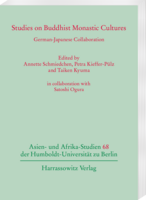|
weitere Titel zum Thema:
Studies on Buddhist Monastic Cultures is based on an online lecture series organised by the former Indology Department of Martin Luther University Halle-Wittenberg, Germany and the Japanese Vihāra Project, supported by the Japanese Society of the Promotion of Science in 2021 and 2022.
Of the three contributions included in this volume, two address the terminology for Buddhist monasteries and nunneries in the early and middle phases of Buddhism in India and Sri Lanka. Petra Kieffer-Pülz investigates the terms vihāra, ārāma, and āvāsa in the Buddhist Pāli literature from its origins to around the 5th/6th centuries CE, focusing on the terminological shifts between the early and later texts and showing that many elements of monastic complexes were not yet mentioned in the earliest writings. Annette Schmiedchen examines the terms vihara, mahāvihāra, and vihāramaṇḍala in Sanskrit epigraphy from Late Antiquity to the Early Middle Ages in various Indian regions, especially Gujarat, Bengal and Andhra Pradesh, and explains the implications of these terminological differences. The third contribution by Shin’ichirō Hori focuses on the evidence for Buddhist monasticism in the phase of its decline in India. Based on dated colophons of Sanskrit manuscripts in Old Bengali script, Hori reveals that despite the widespread disappearance of Buddhism in India by the 13th century CE, Buddhist institutions still persisted in rural areas in Bihar until the mid-15th century CE. |






